Filter by
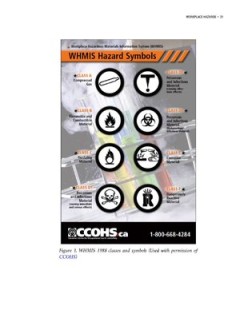
Workplace Safety in the Food Service Industry
Workplace Safety in the Food Service Industry is one of a series of Culinary Arts books developed to support the training of students and apprentices in B.C.’s foodservice and hospitality industry. Your health and well-being are your most valuable possessions. Many laws and regulations exist to ensure employee safety, yet every year thousands of serious injuries occur. In many cases, these in…
- Edition
- -
- ISBN/ISSN
- -
- Collation
- -
- Series Title
- -
- Call Number
- 363.1175 BRI w
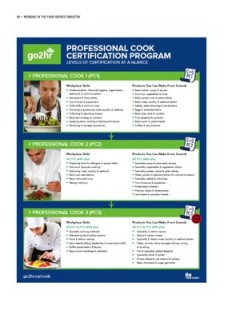
Working in the Food Service Industry
Workplace Safety in the Food Service Industry is one of a series of Culinary Arts open textbooks developed to support the training of students and apprentices in British Columbia’s foodservice and hospitality industry. Although created with the Professional Cook, Baker and Meatcutter programs in mind, these have been designed as a modular series, and therefore can be used to support a wide va…
- Edition
- -
- ISBN/ISSN
- -
- Collation
- -
- Series Title
- -
- Call Number
- 338.19 BRI w
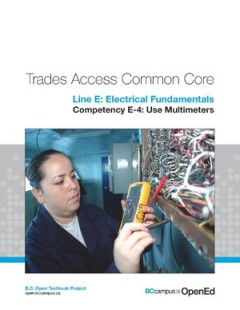
Trades Access Common Core: Line E, Electrical Fundamentals, Competency E-4, U…
Whether you choose to work in an electrical trade, a mechanical trade, or one of the construction trades, you will probably be faced with using and/or maintaining a variety of electrical measuring instruments. This Competency will introduce you to three basic meters for measuring voltage, current, and resistance. You must have a basic understanding of the purpose and operation of each type of m…
- Edition
- -
- ISBN/ISSN
- -
- Collation
- -
- Series Title
- -
- Call Number
- 650 TRA t
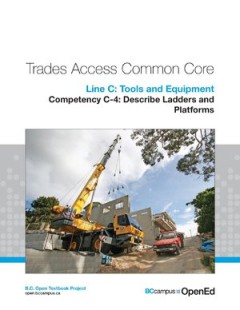
Trades Access Common Core: Line C, Tools Equipment, Competency C-4, Describe …
In this Competency you will learn about some of the common equipment used for performing work at elevated locations. The safe use of ladders and scaffolds is required in all types of jobs. A safely built scaffold provides a stable platform for workers to complete their work. The Occupational Health and Safety (O.H.S.) Regulation has set minimum standards for erecting and using ladders and work …
- Edition
- -
- ISBN/ISSN
- -
- Collation
- -
- Series Title
- -
- Call Number
- 650 TRA t
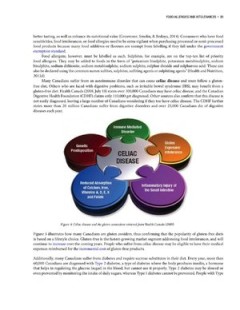
Nutrition and Labelling for the Canadian Baker
This book is intended to give students a basic understanding of nutritional information and labeling in the baking industry. In particular, there is a focus on Canadian regulations regarding labeling and merchandising of baked goods, as well as baking for customers with special diets, allergies, and intolerances. Nutrition and Labeling for the Canadian Baker is one of a series of Culinary Arts …
- Edition
- -
- ISBN/ISSN
- -
- Collation
- -
- Series Title
- -
- Call Number
- 658.82 BRI n
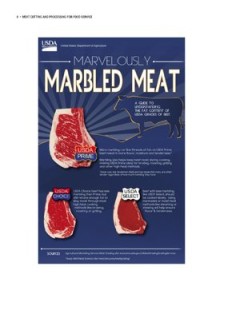
Meat Cutting and Processing for Food Service
This book is intended to give students a basic understanding of the various types of meat and poultry used in the food service industry, and of how the terminology used by retail, wholesale and food service customers varies. Meat cutting for restaurants and hotels differs slightly from meat cutting for retail. Restaurants and hotels sometimes use names of cuts on menus that are common in the ki…
- Edition
- -
- ISBN/ISSN
- -
- Collation
- -
- Series Title
- -
- Call Number
- 664.024 BRI m
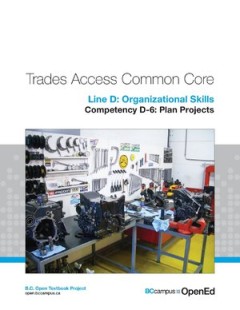
Line D: Organizational Skills, Competency D-6, Plan Projects
Every job is different and may have special requirements. Anticipating these requirements and planning accordingly is vital to ensuring that you have the materials, tools and time to complete the job. To do this effectively you will need to have a clear understanding of the overall job. You will need to know what materials are required and be able to record organized and accurate notes on the t…
- Edition
- -
- ISBN/ISSN
- -
- Collation
- -
- Series Title
- -
- Call Number
- 650.07 COL l
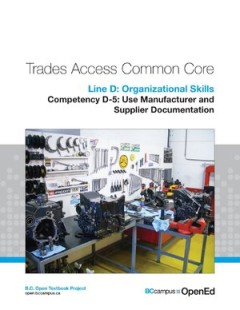
Line D: Organizational Skills, Competency D-5, Use Manufacturer and Supplier …
Document use is one of the nine essential skills identified by the Government of Canada to be successful in the workplace. It refers to the skills needed to find, enter and use letters, numbers, symbols and images in electronic and paper form. In the trades, people use document literacy skills to find and enter information in forms, lists, tables, graphs, maps and drawings. The following list o…
- Edition
- -
- ISBN/ISSN
- -
- Collation
- -
- Series Title
- -
- Call Number
- 650.07 COL l
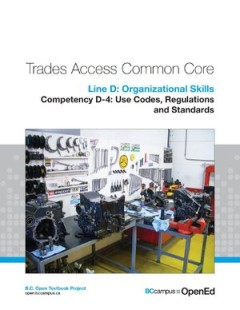
Line D: Organizational Skills, Competency D-4, Use Codes, Regulations and Sta…
Codes, regulations, standards, specifications and recommended practices are used in all aspects of construction, fabrication, manufacturing and inspection. The following list of lines and competencies was generated with the goal of creating an entry-level trades training resource, while still offering the flexibility for lines to be used as stand-alone books. Line D – Organizational Skills. D…
- Edition
- -
- ISBN/ISSN
- -
- Collation
- -
- Series Title
- -
- Call Number
- 650.07 COL l

Line D: Organizational Skills, Competency D-1, Solve Trades Mathematical Prob…
Essential skills are used in every job to varying degrees and at different levels of complexity. They provide the foundation for learning all other skills and enable people to evolve in their jobs and adapt to changes in the workplace. The following list of lines and competencies was generated with the goal of creating an entry-level trades training resource, while still offering the flexibilit…
- Edition
- -
- ISBN/ISSN
- -
- Collation
- -
- Series Title
- -
- Call Number
- 650.07 COL l
 Computer Science, Information & General Works
Computer Science, Information & General Works  Philosophy & Psychology
Philosophy & Psychology  Religion
Religion  Social Sciences
Social Sciences  Language
Language  Pure Science
Pure Science  Applied Sciences
Applied Sciences  Art & Recreation
Art & Recreation  Literature
Literature  History & Geography
History & Geography